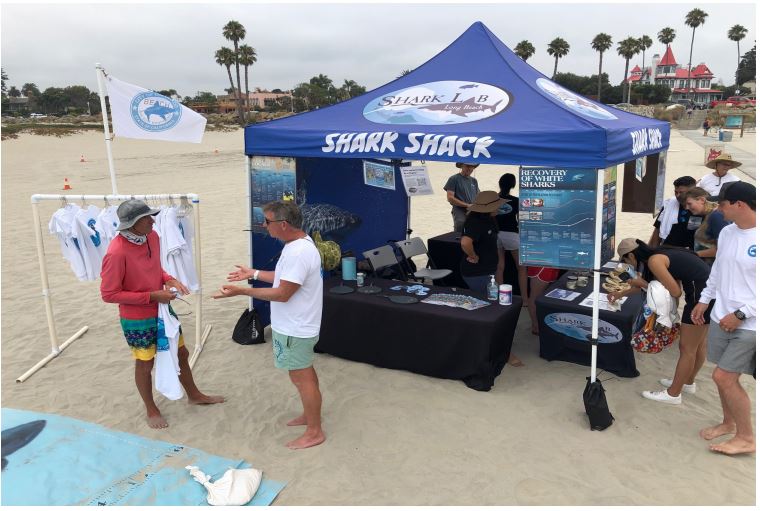Congratulations! You found us at the California State University Long Beach, SHARK SHACK Tuesday at Coronado’s Central Beach and scored!
Over 100 of you are now “Sporting and Supporting” local advocacy for Live Buoy Monitoring in Coronado. Armed with your Shark Lab, SHARK SHACK knowledge and your FREE LIVE BUOY MONITORING T-shirt and Stickers, you can call, email and send a message to Coronado City Hall about this important upgrade to our current “dumb” system. What’s that? You missed Tuesday’s opportunity! No FOMO worries. Another FREE T-shirt and Sticker opportunity is on the next BluHorizon … Thanks to all of you who came out and for becoming an advocate. Wearing your LIVE BUOY MONITORING T-shirt shows your support and stirs conversation for expanding this exciting Safety, Science and Education partnership program with California State University Long Beach, along Coronado’s 1.7 miles of Pacific Ocean, Beach Shoreline.
On Tuesday morning, August 17th, a team of undergraduate students from Dr. Chris Lowe’s Cal State University Long Beach Shark Lab team set up their interactive “Shark Shack” exhibit at Coronado’s Center Beach right next to the main Lifeguard Tower. CSULB Shark Lab Science Educator, Corina Silva and undergraduates Taylor Woodruff, Eleni Wojcik and Gigi Fernandez were joined by local resident waterman and Live Buoy Monitoring advocate Steve Ogles, of Watershot Incorporated.

Beach patrons young and old were drawn to the display, where the undergraduates explained shark and stingray behavior and physiology as well as answered questions using models, preserved white shark jaws, shark eyes (yes, the white sharks can see very well), stingray stingers and other visual aids that the public could pick up and touch as well as informative posters and a giant 16 foot plastic banner printed with a white shark and measuring line marked in feet. You then get an idea of a 5 foot baby white shark versus and 8 or 9 foot juvenile or 12 foot adult. Their litters can range from two to ten baby white sharks from 3.5 to 5 feet long pups fully equipped to hunt stingrays and halibut. One of the pairs of jaws was from a 5 foot newborn. The undergraduates adroitly responded to sophisticated questions from adults as well as engaging very young children about local sea life.
CSU Long Beach students, graduate and undergraduate, always have something new and interesting to share one new fact regarding stingray barbs and poison. The barbs are hard cartilage and as sharp as serrated knives but are not poisonous in themselves. However, stingrays secrete a venomous mucus around the barbs which cause the sting. This is quite different than bees which inject poison from a sac into the stinger then into the victim. As an added bonus, Steve Ogles handed out Coronado Live Buoy Shark Monitoring T-shirts, you can’t buy ‘em to help raise awareness and support for the suite of live buoys to monitor tagged white sharks. So far seven white sharks have been tagged right off Coronado’s main beach since November 2020 and more have been seen by local swimmers, surfers, BUD/S and SWCC instructors. And there has been one direct encounter in December 2020 with a swimmer. The undergraduates also handed out educational comics that deal with beach safety including rip currents, stingrays and of course sharks. The Shark Lab folks would be happy to come back for more educational opportunities and perhaps meet up with the Coronado Junior Guards next summer.





